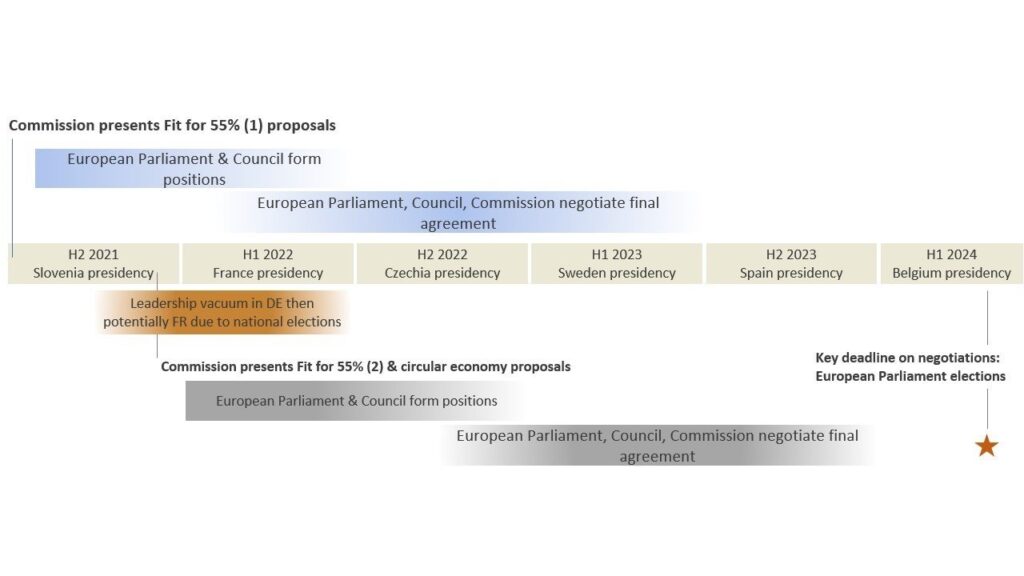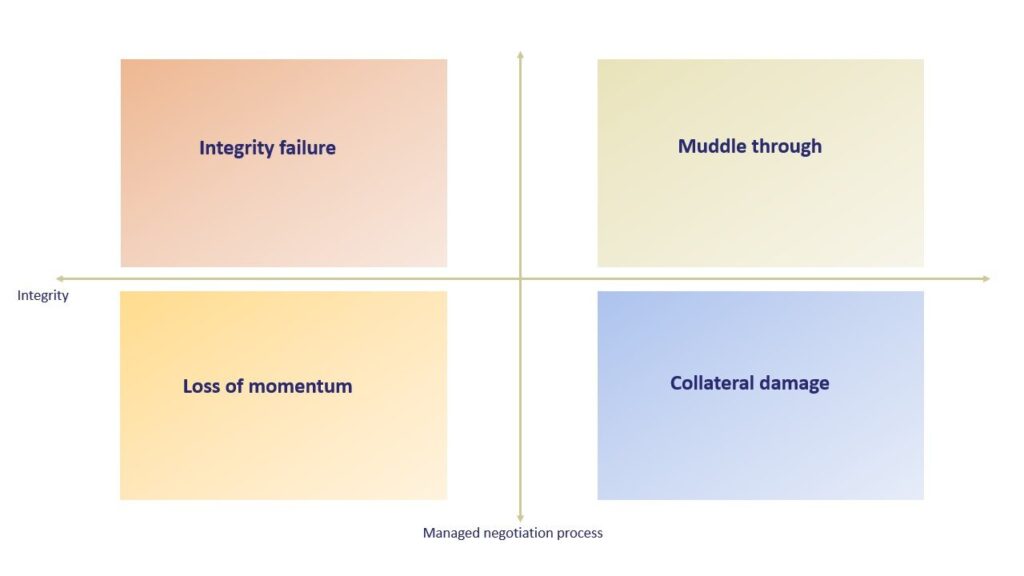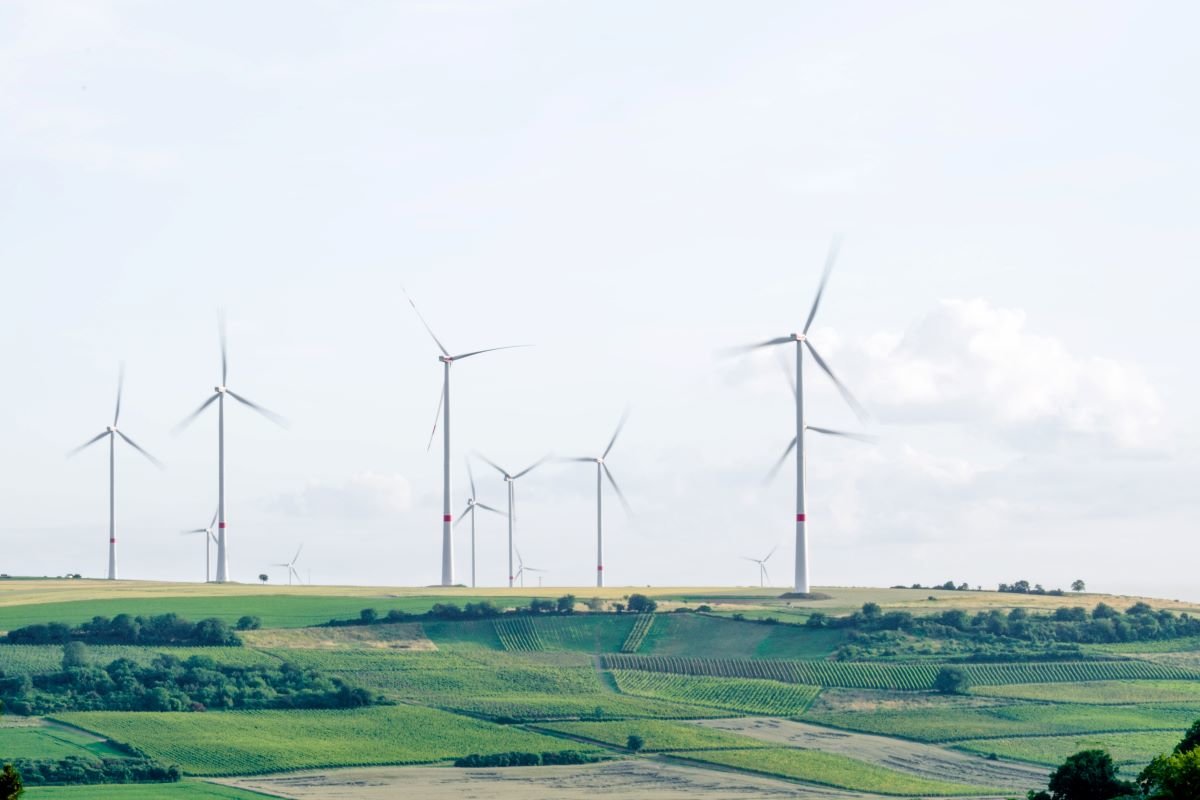It was supposed to be the cornerstone of the “European Green Deal” (the EU’s roadmap to climate neutrality), Europe’s “man-on-the-moon moment”, a definitional piece of the legacy of the current EU leadership. Does the “Fit for 55” package live up to expectations?
Overall assessment
The European Commission’s proposals to deliver the European Green Deal are impressive. They are laying out the necessary architecture and measures needed to drive a fair socio-economic transformation to climate neutrality.
Key elements of the proposals must however be strengthened through the upcoming negotiations to not only pick up the pace on the transformation of EU heating, power, and industrial sectors, but also boost its social and international credibility. Additional proposals on gas, buildings, industry and product regulations could also tip the balance of ambition and credibility in either direction.

E3G’s Fit for 55 benchmark briefings on industrial transition; transition away from fossil gas; buildings transformation; and the social dimension provide detailed assessments of the proposals.
What’s next?
Negotiations between the European Parliament and the Council of the EU on these proposals will take years. Our estimate is that it will take a minimum of two years, with negotiators scrambling to agree by late 2023.

The risk of delivery failure of the “Fit for 55” package remains high. Four scenarios can be envisaged for what will be a complex, drawn-out negotiation process:

- Loss of momentum: In this scenario, negotiations grind to halt due to a lack of administrative capabilities. Overstretched EU and national administrative services struggle with the size and complexity of the package, upcoming presidencies (apart from France) lack capacity to steer “Fit for 55” through the Council. Capitals get bogged down in endless discussions on legal bases and competences – a risk that is especially high around the energy taxation directive – while the Commission is too exhausted to maintain the impetus throughout years of negotiations. Only a handful of the proposals are adopted before the end of the mandate.
- Collateral damage: In this scenario, negotiations on “Fit for 55” are hijacked by developments that are adjacent to the package. Operationalizing the Social Climate Fund will require amending the EU’s multiyear budget, as well as an instrument (the Own Resources Decision) that will also have to jump through the hoops and loops of ratification by national parliaments. This effectively gives less ambitious Member States significant leverage in the negotiations; crucially, it can also easily get entangled in domestic politics. Failure to agree on these texts would derail the negotiations on the package. That Hungary will head to the polls in 2022, while the Polish coalition looks increasingly unstable, is moderately reassuring in that context.
- Integrity failure: The most likely scenario would see Member States watering down the package under the combined effects of intense resistance from incumbent industries, fear of social backlash on the left, and fear of loss of economic competitiveness on the right. Meanwhile, with the end of its term drawing nearer, the Commission would become more preoccupied by its legacy and would focus on getting the package adopted rather than on preserving its level of ambition. All proposals would be approved before the end of the mandate, but in a version that would not deliver the target of at least -55% by 2030.
- Muddling through: The upside scenario would see the package muddle through, with limited concessions to incumbent industries. The 2021 federal election in Germany and the 2022 presidential election in France would signal strong social license for ambitious climate action; progressive Member States would succeed in using the political momentum from these elections, or political developments abroad (for instance in the U.S.) and continued support in civil society, to preserve (more or less) the overall integrity of “Fit for 55”. Less ambitious Member States would focus their efforts on maximizing additional funding and revenues to facilitate their transition, rather than on weakening the overall ambition of the package.
Key factors for success
Year-long negotiations lie ahead. The “Fit for 55” proposals signalled real political determination; delivery will be an entirely different matter. The best-case scenario (“muddling through”) is not terribly ambitious, yet even this will require significant investment by European institutions, national governments, and all stakeholders. Key factors for success include:
- Civil society organisations and progressive businesses will need to follow the negotiations closely, be vigilant throughout and seek cohesion among themselves to land a robust and ambitious package.
- European Commission leadership and services will need to deploy significant capacity in support to upcoming presidencies. Member States will need to proactively build bridges between different factions.
- Leadership from Heads of State and Government will be needed to steer adjacent negotiations on the budget, and social requirements for a successful transition to climate neutrality. With Germany potentially in a leadership vacuum following the September 2021 elections, such leadership would need to come from a wider range of countries.
- Progress on international climate negotiations in the run-up to COP26 at the end 2021 would put wind in the sails of these negotiations. Enhanced international engagement by European diplomacy, whether from Brussels or other capitals, in the context of G7, G20 or the UNFCCC, would drive more ambition internationally and domestically.
This project has received funding from the LIFE Programme of the European Union.




